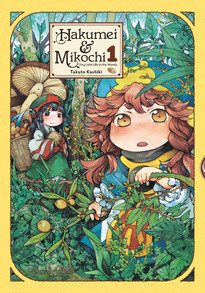Review
by Rebecca Silverman,Hakumei & Mikochi: Tiny Little Life in the Woods
GN 1
| Synopsis: |  |
||
Deep in the forest live a race of tiny people, coexisting with the animals and plants they live beside. Hakumei and Mikoshi are best friends and roommates, sharing a home on a small hill. Together they explore the world around them, go shopping in the closest town, and meet a variety of people, from a mad scientist to a friendly beetle to a bard. It's a tiny little life, but it's also an enchanting one. |
|||
| Review: | |||
Readers of a certain age will remember a 1980s TV show called “The World of David the Gnome.” If you grew up watching it, or its original Spanish-language broadcast “David el gnomo,” reading Hakumei & Mikochi - Tiny Little Life in the Woods may give you flashbacks to the sweet adventures of the little people with the pointy hats. The only real similarities, however, are the gentle pacing and the fact that the gnomes and the characters of this manga are tiny – Hakumei & Mikochi really isn't a children's story and their world stretches out just a little bit farther. Although creator Takuto Kashiki never gives them a specific species, it's easy to think of the diminutive forest-dwellers in his book as being koropokkur, a mythological fairy race native to Hokkaido. They certain can hide under leaves like the koropokkur, and they appear to share not only their stature, but their agility and skill at survival through living off the land. While Hakumei's profession as an engineer is probably a bit more technological than the people of Ainu myth, they could also simply be read as modern incarnations of the myth, because after all, the stories say that humans haven't seen koropokkur for hundreds of years, but that doesn't mean that they aren't still around. However you interpret their existence, Hakumei & Mikochi is an undeniably cute book. The two tiny women play off each other well, even though we're clearly not privy to a lot of their history. We do learn over the course of the volume that Mikoshi took Hakumei in when she was homeless and that Mikochi is the more sophisticated of the two, with more social experience and perhaps slightly better life skills in general, but they enjoy their differences as something that makes them better friends. (The dearth of male characters in the story, at least who interact with the two of them, does make a reading where they are more than friends possible; it isn't really mentioned in the text, however.) Both seem to think that they need to take care of the other, with Hakumei determined to do her share of the work and Mikochi trying to expand Hakumei's horizons when they take trips into town. Although it isn't harped on, the relationship between the two really is a centerpiece of the story, and while they clearly have their own friends and activities separate from each other, they're also undeniably a pair. The pacing of the book is very slow. Chapters are not necessarily continuous, with each telling a separate story, although characters do recur once we meet them. (Anime viewers will notice that the first episode of the adaptation covers chapter one and chapter six of this volume.) There's nothing about the book, however, that suggests that it is following any sort of time line; instead it just meanders along with a different focus each time. The fact that we're not coming in when the two ladies met is a large factor in the nonlinear way the book is written; plenty of references are made to events that happened outside of the story. Instead of being confusing, however, they simply give the impression that the author has built a very complete world for his characters to live in. This is backed up by the artwork. While Hakumei and Mikochi themselves have cartoony faces and the impossibly tiny peg-feet of an antique clothespin doll, the backgrounds are lush and fully realized. Branches and stems tangle around the page, pebbles become boulders, and beetles are transport animals in the ladies' world. Their clothing also shows impressive amounts of detail, and their large, round faces serve just as much to allow us to see their expressions in their small scale as to make them appealingly adorable. There's also a very nice variety of designs for the other people, and animals look like animals rather than being giving human characteristics; the weasel might wear a headband, but he's still recognizably a weasel, not a long, furry human with a tail. Because the story moves so slowly and is largely devoid of major plot points and revelations, this is much more a book for slice-of-life fans or cute girl stories than anyone looking for a new fantasy series. It can drag at times, especially when it feels like Kashiki is going out of his way to stretch a scene to its limits (the tavern chapter is a good example of this), but if you don't need an exciting story to go with your world-building, this is very much worth it. Hakumei & Mikochi do live a tiny little life in the woods, as advertised. It's a nice place to stop by when you need an escape from a big busy life in the world. |
| Grade: | |||
|
Overall : B
Story : B-
Art : A
+ Beautiful art, terrific world-building |
|||
|
discuss this in the forum (6 posts) |
this article has been modified since it was originally posted; see change history |
|||
| Production Info: | ||
|
Full encyclopedia details about Release information about |
||